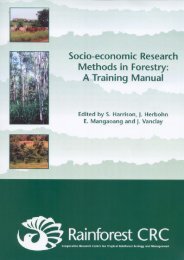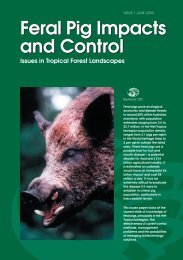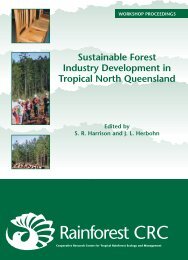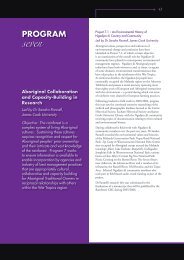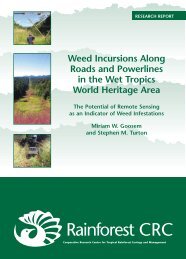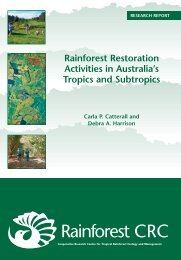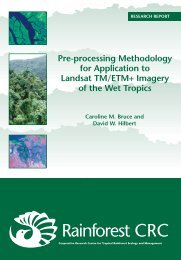Reconciling Nature and Culture in a Global Context? - Rainforest ...
Reconciling Nature and Culture in a Global Context? - Rainforest ...
Reconciling Nature and Culture in a Global Context? - Rainforest ...
Create successful ePaper yourself
Turn your PDF publications into a flip-book with our unique Google optimized e-Paper software.
S<strong>and</strong>ra PannellTHE MILITARY FORTRESS OF SUOMENLINNA: A CASE OF POST-COLONIAL REMEMBERING?The sea fortress of Suomenl<strong>in</strong>na (Figure 14) is built on a number of isl<strong>and</strong>s located at theentrance to the harbour of Hels<strong>in</strong>ki <strong>in</strong> F<strong>in</strong>l<strong>and</strong>. As one of F<strong>in</strong>l<strong>and</strong>’s first World Heritage sites,the fortress was listed <strong>in</strong> 1991 as a ‘cultural’ property under criterion (iv), <strong>and</strong> is thusidentified as “an especially <strong>in</strong>terest<strong>in</strong>g example of European military architecture of the time”(UNESCO World Heritage Centre website). Often referred to as the ‘Gibraltar of the North’,this site is “one of the largest sea-fortresses <strong>in</strong> the world” (The Estate of Olof af Hällstrom2004: 4). Information brochures for the site proclaim the fortress as a “national monument”<strong>and</strong> “one of F<strong>in</strong>l<strong>and</strong>’s cultural treasures” (Suomenl<strong>in</strong>na Sveaborg 2005).Visitors to the Suomenl<strong>in</strong>na Visitor Centre, completed <strong>in</strong> 1998 to mark the 250 th anniversaryof the fortress, can take <strong>in</strong> a wide-screen audio-visual presentation of Suomenl<strong>in</strong>na’s history,dubbed the ‘Suomenl<strong>in</strong>na Experience’. They can also exam<strong>in</strong>e the many detailed bi-l<strong>in</strong>gual(<strong>in</strong> the national languages of F<strong>in</strong>nish <strong>and</strong> Swedish) 51 exhibits, which plot the chronologicaldevelopment of this significant example of military architecture. Unlike many other WorldHeritage sites visited <strong>in</strong> the course of this research project (see also Williams 2005), theSuomenl<strong>in</strong>na Visitor Centre clearly identifies the site as World Heritage, provides detailed<strong>in</strong>formed about the values the property is listed for, <strong>and</strong> also contextualises this <strong>in</strong>formationwith a display on the World Heritage Convention. With<strong>in</strong> the grounds of the fortress are alsoseveral museums, which display “F<strong>in</strong>l<strong>and</strong>’s defence <strong>and</strong> war history” (Suomenl<strong>in</strong>na Sveaborg2005). In addition to these displays <strong>and</strong> <strong>in</strong>terpretive material, visitors are given an<strong>in</strong>formation brochure, available <strong>in</strong> several European languages, <strong>and</strong> can purchase morecomprehensive accounts on the history <strong>and</strong> architecture of the fortress <strong>in</strong> the visitor centrebookshop. Included <strong>in</strong> these more comprehensive accounts is the official guidebook,UNESCO-World Heritage endorsed ‘Look at Suomenl<strong>in</strong>na-Sveaborg: The Isl<strong>and</strong> Fortress offHels<strong>in</strong>ki’ (The Estate of Olof af Hällstrom 2004). Apart from stopp<strong>in</strong>g at the visitor centre,visitors are also encouraged to experience the fortress by tak<strong>in</strong>g one of a number of markedwalk<strong>in</strong>g tours of the restored <strong>and</strong> well-preserved complex.As a visitor to this World Heritage site, one readily learns that the construction of the fortressbegan <strong>in</strong> 1748 <strong>and</strong> that, up until thirty years ago, the edifice was still used by the military(Suomenl<strong>in</strong>na Sveaborg 2005). Sveaborg was named <strong>in</strong> 1750 52 . In the period 1748-1808,the fortress <strong>and</strong> the area which was later to become the <strong>in</strong>dependent republic of F<strong>in</strong>l<strong>and</strong> <strong>in</strong>1918, were ruled by the K<strong>in</strong>g of Sweden. As stated <strong>in</strong> one of the available <strong>in</strong>formationbrochures, as part of a military alliance <strong>and</strong> defence plan with France, the fortress wasconstructed by Sweden to counter the grow<strong>in</strong>g threat from Russia. It also represented a “lastattempt […] to reclaim the l<strong>and</strong> it had lost to Russia at the turn of the century” (Suomenl<strong>in</strong>naSveaborg 2005). While considered to be ‘impenetrable’, Sweden surrendered to Russia <strong>in</strong> asiege of the fortress <strong>in</strong> 1808. From 1808 until the October Revolution of 1917, F<strong>in</strong>l<strong>and</strong> cameunder the ‘hegemony’ of the Russian Empire (Suomenl<strong>in</strong>na Sveaborg 2005). In 1855,Sveaborg, as a Russian fortress <strong>and</strong> garrison town, was attacked by Great Brita<strong>in</strong> <strong>and</strong>France <strong>in</strong> one of the battles of the Crimean War (1853-1856). While the bomb<strong>in</strong>g of thefortress had “no military significance” for Great Brita<strong>in</strong> <strong>and</strong> France, it became apparent to theRussians that “ancient Sveaborg was hopelessly outdated (The Estate of Olof af Hällstrom2004: 47). In the aftermath of F<strong>in</strong>nish Independence <strong>in</strong> 1917, the fortress was renamed51 For visitors not speak<strong>in</strong>g either of the two national languages of F<strong>in</strong>l<strong>and</strong>, dense <strong>and</strong> overly longphotocopied texts are available <strong>in</strong> English, German, French, Russian <strong>and</strong> Japanese as analternative to the detailed <strong>in</strong>terpretive displays panels <strong>in</strong> the visitor centre.52 While officially named Sveaborg by Sweden, the fortress was also known as Viapori <strong>in</strong> the F<strong>in</strong>nishlanguage (The Estate of Olof af Hällstrom 2004: 32). Apparently, when the Russians occupied thefortress <strong>in</strong> 1808, the name, Viapori, was also used by them.48




